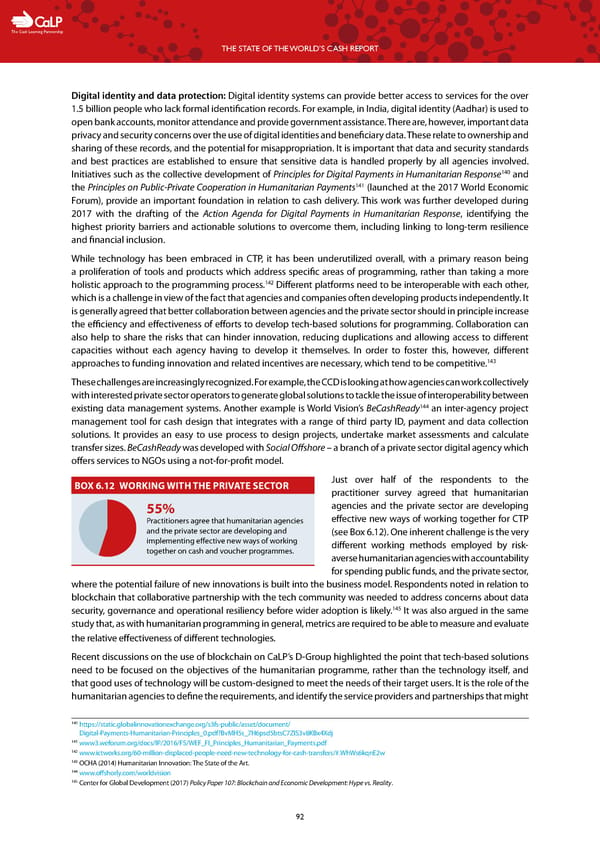C The Cash Learning Partnership THE STATE OF THE WORLD’S CASH REPORT Digital identity and data protection: Digital identity systems can provide better access to services for the over 1.5 billion people who lack formal identification records. For example, in India, digital identity (Aadhar) is used to open bank accounts, monitor attendance and provide government assistance. There are, however, important data privacy and security concerns over the use of digital identities and beneficiary data. These relate to ownership and sharing of these records, and the potential for misappropriation. It is important that data and security standards and best practices are established to ensure that sensitive data is handled properly by all agencies involved. 140 Initiatives such as the collective development of Principles for Digital Payments in Humanitarian Response and 141 the Principles on Public-Private Cooperation in Humanitarian Payments (launched at the 2017 World Economic Forum), provide an important foundation in relation to cash delivery. This work was further developed during 2017 with the drafting of the Action Agenda for Digital Payments in Humanitarian Response, identifying the highest priority barriers and actionable solutions to overcome them, including linking to long-term resilience and financial inclusion. While technology has been embraced in CTP, it has been underutilized overall, with a primary reason being a proliferation of tools and products which address specific areas of programming, rather than taking a more 142 holistic approach to the programming process. Different platforms need to be interoperable with each other, which is a challenge in view of the fact that agencies and companies often developing products independently. It is generally agreed that better collaboration between agencies and the private sector should in principle increase the efficiency and effectiveness of efforts to develop tech-based solutions for programming. Collaboration can also help to share the risks that can hinder innovation, reducing duplications and allowing access to different capacities without each agency having to develop it themselves. In order to foster this, however, different approaches to funding innovation and related incentives are necessary, which tend to be competitive.143 These challenges are increasingly recognized. For example, the CCD is looking at how agencies can work collectively with interested private sector operators to generate global solutions to tackle the issue of interoperability between 144 existing data management systems. Another example is World Vision’s BeCashReady an inter-agency project management tool for cash design that integrates with a range of third party ID, payment and data collection solutions. It provides an easy to use process to design projects, undertake market assessments and calculate transfer sizes. BeCashReady was developed with Social Offshore – a branch of a private sector digital agency which offers services to NGOs using a not-for-profit model. BOX 6.12 WORKING WITH THE PRIVATE SECTOR Just over half of the respondents to the practitioner survey agreed that humanitarian 55% agencies and the private sector are developing Practitioners agree that humanitarian agencies effective new ways of working together for CTP and the private sector are developing and (see Box 6.12). One inherent challenge is the very implementing effective new ways of working different working methods employed by risk- together on cash and voucher programmes. averse humanitarian agencies with accountability for spending public funds, and the private sector, where the potential failure of new innovations is built into the business model. Respondents noted in relation to blockchain that collaborative partnership with the tech community was needed to address concerns about data security, governance and operational resiliency before wider adoption is likely.145 It was also argued in the same study that, as with humanitarian programming in general, metrics are required to be able to measure and evaluate the relative effectiveness of different technologies. Recent discussions on the use of blockchain on CaLP’s D-Group highlighted the point that tech-based solutions need to be focused on the objectives of the humanitarian programme, rather than the technology itself, and that good uses of technology will be custom-designed to meet the needs of their target users. It is the role of the humanitarian agencies to define the requirements, and identify the service providers and partnerships that might 140 https://static.globalinnovationexchange.org/s3fs-public/asset/document/ Digital-Payments-Humanitarian-Principles_0.pdf?BvMH5s_7H6psd5btsC7ZIS3v8KBx4Xdj 141 www3.weforum.org/docs/IP/2016/FS/WEF_FI_Principles_Humanitarian_Payments.pdf 142 www.ictworks.org/60-million-displaced-people-need-new-technology-for-cash-transfers/#.WhWs6kqnE2w 143 OCHA (2014) Humanitarian Innovation: The State of the Art. 144 www.offshorly.com/worldvision 145 Center for Global Development (2017) Policy Paper 107: Blockchain and Economic Development: Hype vs. Reality. 92
 The State of the World's Cash | Full Report Page 93 Page 95
The State of the World's Cash | Full Report Page 93 Page 95